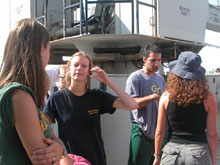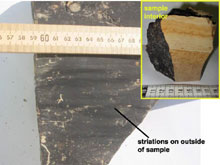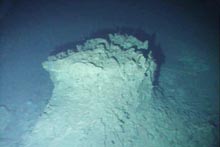
A transect from northeast to southwest across a small diapir within the Cape Fear slide scar (north diapir) and the Cape Fear Diapir itself reveals the dramatic seafloor relief. The Cape Fear Diapir protrudes as much as 275 meters above the surrounding slide scar and is bounded by faults. The top of the diapir has a sediment pond thick enough to be easily distinguished in this profile. At the location of this crossing, the northern diapir is covered by slide rubble carried downslope perpendicular to the page. Farther to the east, the diapir is exposed at the surface. Timing marks are at 15 minute intervals. Image courtesy of C. Ruppel. Click image for larger view.
An Uphill Climb (Dive 3914)
August 1, 2003
Dr. Carolyn Ruppel, Co-Chief Scientist
Associate Professor
Georgia Institute of Technology
Catalina Martinez, Mission Coordinator
NOAA Office of Ocean Exploration
In their final attempt to locate methane seeps, the geophysics members of the scientific party (Chief Scientist Carolyn Ruppel and University of Wyoming participants Steve Holbrook and Matt Hornbach) surveyed the seafloor until nearly daybreak, seeking to optimize the choice of final dive sites near the Cape Fear Diapir. Considering the characteristics that had likely contributed to the development of a cold seep chemosynthetic community on the Blake Ridge Diapir, the scientists reasoned that they should choose as a dive target a sedimented and faulted region on top of or adjacent to a salt diapir. Sediment provides the organic carbon that microbes degrade to make methane. Faults tap into deeper, older gas and provide conduits for hot fluids and gas to reach the surface. The thermal properties of salt diapirs cause thinning of the gas hydrate zone and the occurrence of free gas closer to the surface. Diapirs also enhance both thermal and chemical gradients that drive fluid flow.

Geogia Tech graduate student Rob Martinez and College of William and Mary undergraduate Julianne Pupa speak excitedly with other members of the science party after their traditional iced seawater dousing that followed their first Alvin dive. Photo courtesy of T. Piper. Click image for larger view.
With Alvin pilot Bruce Stickrott at the controls, Georgia Tech Ph.D. student Rob Martinez and William and Mary undergraduate Julianne Pupa embarked on their first dive. The dive track would take them up a canyon at the base of the Cape Fear Diapir and then as far up the flank of the diapir as possible before the sub had to ascend to the surface. A bottom simulating reflector that marks the top of free gas beneath a layer of gas hydrate had been previously imaged to the west of the dive site, and the seafloor landing location was chosen to traverse an area where this free gas could potentially meet the seafloor adjacent to a major fault bounding the diapir.
For Rob Martinez, who is researching the microbial ecology of seeps in the laboratory of Dr. Patricia Sobecky of the School of Biology at Georgia Tech, and Julianne Pupa, who is a biology major at The College of William and Mary, this dive would be a challenge that would tax their ability as scientific observers. Martinez, who dived as the lead observer, was briefed on the geologic features Alvin was likely to encounter and instructed on collection of geologic samples.

This schematic demonstrates the principle underlying subseafloor imaging with an acoustic system.The outside of the rock (left) obtained along the steep southeastern slope of the Cape Fear Diapir is covered with striations possibly related to faulting, while the interior of the rock (right) is strongly layered and has interesting fine-scale features related to deformation that occurred as the sediments were deposited. Photo by A. Eisin. Click image for larger view.
Hours later, both observers returned to deck of the R/V Atlantis enthralled by the landscape they had encountered. They described a seafloor of steep rock faces, striations, rubble piles, mud chimneys, and numerous pits with strange discoloration. Early in the dive, Alvin discovered cylindrical 1.5-meter-diameter mud chimneys rising a meter above the seafloor. Samples obtained by Alvin revealed that the outer layer of the column consisted of fine clay with burrows oriented in all directions. Some of these burrows were lined by iron oxide. Still unknown is the composition of material supporting the internal structure of the columns. Alvin also obtained a sample of mudstone, the lithified version of clay, that was being reworked and burrowed as it has softened during exposure to seawater.
As they ascended the side of the diapir, Pilot Strickrott obtained a sample of fresh rock on a dipping face. The rock led to great excitement among the geologists upon Alvin’s return to the surface. Surface striations on the rock might be related to fault movement, and the location of this rock on the side of the diapir where faulting must have occurred to accommodate the upward rise of the salt through the surrounding sediments lends credence to this interpretation. The interior of this beige carbonate has well-defined layering, and microfossils and soft sediment features are visible upon closer examination.

An example of a mud chimney encountered during Dive 3914. The outer part of the chimney consists of pervasively burrowed fine clay, but Alvin did not obtain a sample of the interior of the feature. Photo courtesy of WHOI. Click image for larger view.
Finding no evidence for seep communities, the observers felt obliged to return to the surface with a purple sea cucumber and a brightly-colored sea star. While the science party would have liked to have stumbled upon previously unknown cold seeps associated with gas hydrates in this part of the Atlantic, all aboard were pleased to have achieved the seven scheduled Alvin dives and to have had the opportunity to explore new parts of the seafloor where scientists had thought methane seeps might occur. The findings of The Windows to the Deep are already leading the scientists to revise the criteria used to search for cold seeps in these challenging settings and a consideration of new results about the relationship of gas hydrates to seafloor seeps, submarine slides, and global climate change.


















